The most likely crash site of the missing Malaysian Airlines jet MH370 has yet to be searched, a UK satellite company has claimed - because the ship sent there was diverted to take part in the fruitless pursuit of 'pings' that were believed to be from the plane.
A major search for Flight MH370 has been under way since it disappeared with 239 passengers and crew on board after taking off from Kuala Lumpur bound for Beijing on March 8.
With no sign of the plane being found yet, the internet and media have been awash with conspiracy theories about what happened.

Three months after MH370 vanished, the fate of the 239 people aboard remains a mystery
But scientists from telecommunications experts Inmarset said they had located a "hotspot" on the floor of the Indian Ocean that is still unsearched - because the ship sent there picked up other signals, thought to be from the plane's flight recorders, and went to investigate them insteaad.
Hourly electronic connections received by compant revealed that the Boeing 777 airliner had to have come down in the southern Indian Ocean.
Its scientists told the BBC's Horizon programme they had calculated the plane's most likely flight path to a "hotspot" on the ocean floor.
An Australian search vessel, the Ocean Shield, never reached the site because it was diverted after picking up the other signals some distance away.
STORY CONTINUES BELOW SLIDESHOW
These "pings" were investigated for two months during a search of 328 square miles of sea bed north west of Perth in Australia but the source was not found.
Chris Ashton, from Inmarsat, told Horizon: "It was by no means an unrealistic location but it was further to the north east than our area of highest probability."
The company modelled a series of arcs across the Indian Ocean based on a likely speed and heading if the plane was flown on autopilot, and found a path that lined up with data gathered from where its systems made contact with the jet.
He said: "We can identify a path that matches exactly with all those frequency measurements and with the timing measurements and lands on the final arc at a particular location, which then gives us a sort of a hotspot area on the final arc where we believe the most likely area is."
A number of countries are continuing to negotiate on how to fund the next phase search, which will cover almost 21,600 square miles of seabed beneath water up to 4.3 miles deep.
